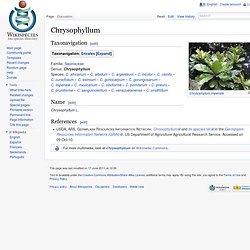

Chrysophyllum. [edit] Familia: Sapotaceae Genus: Chrysophyllum Species: C. africanum – C. albidum – C. argenteum – C. bicolor – C. cainito – C. cuneifolium – C. eximium – C. gonocarpum – C. gorungosanum – C. imperiale – C. mexicanum – C. oliviforme – C. pomiferum – C. prieurii – C. pruniforme – C. sanguinolentum – C. venezuelanense – C. viridifolium Name[edit]

Chrysophyllum. Chrysophyllum is a genus of about 70-80 species of tropical trees, growing rapidly to 10–20 m or more in height.

The genus is native to tropical regions throughout the world, with the greatest number of species in northern South America. One species, C. oliviforme, extends north to southern Florida. The leaves are oval, 3–15 cm long, green above, densely golden pubescent below, from which the genus is named.[2] The flowers are small (3–8 mm), purplish white and have a sweet fragrant smell; they are clustered several together, and are hermaphroditic (self fertile). The fruit is edible; round, usually purple skinned (sometimes greenish-white), often green around the calyx, with a star pattern in the pulp; the flattened seeds are light brown and hard.
The fruit skin is chewy like gum, and contrary to some reports, is edible.